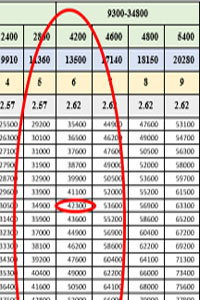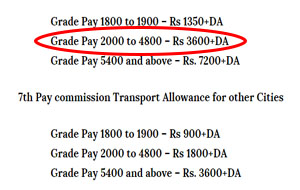Postal Services Board :
The
Commission has examined the demand for granting apex level to the
members of the PSB and is of the view that adequate functional
justification for the same does not exist. ( Para 11.8.11)
The
Commission however is no t in favour of creating an additional post of
member to discharge the financial function and is of the view that the
portfolios of the six members can be so re-arranged that the need to
create a new post of Member is obviated. ( Para 11.8.12)
IPS (Group – A):
In so far
as Director, National Postal Academy is concerned, the view taken is
that functional justification from upgrading the post to Apex level does
not exist. As far as the rest of the demands for upgradation / creation
of posts are concerned, these are administrative matters, which may be
taken up with the concerned departments in the government. ( Para
11.8.15)
Postmaster Cadre :
The
Commission recommends that while 25 percent of the posts of Senior Post
Master may continue to be filled up from Post Master Gr.III through
seniority based promotions, eligible officers from the Post Masters’
cadre (Postmaster Gr.II and Postmaster Gr.III) may also be permitted to
appear for LDCE along with Inspector (Posts) for the balance 75 percent
of the Senior Postmasters’ posts ( Para 11.8.18)
Inspector Cadre :
The
Commission, therefore, recommends that Inspector (Posts) who are
presently in the GP 4200 should be upgraded to GP 4600. With this
upgradation, Inspector (Posts) shall come to lie in an identical grade
pay as that of their promotion post of Assistant Superintendent of Posts
(ASPOs). A higher grade would thus need to be extended to ASPOs.
Accordingly, the Commission recommends that the promotional post of
ASPOs be placed in the next higher GP 4800 and further, the post of
Superintendent (Posts), which is presently in the GP 4800, be moved up
to GP 5400 (PB-2). ( Para 11.8.21)
Postal Assistants / Sorting Assistants / LSG / HSG-II / HSG-I:
The
Commission is of the view that there is no justification
for enhancement of minimum educational qualifications for Direct
Recruits for Postal Assistants/Sorting Assistants from Class XII to
Graduation and the entry grade pay from GP 2400 to GP 2800. No
justification for upgrading LSG, HSG-II & HSG-I (Para 11.8.23 &
11.8.24)
P A ( SBCO) :
The
Commission is therefore of the view that no upgradation is warranted.
As regards grant of cash handling allowance, the Commission is of the
view that with the spread of banking and internet based payments coming
into vogue there is no merit in granting an allowance for handling cash.
( Para 11.8.27).
Postman :
The
Commission has noted the entry level qualifications prescribed (Class X
or ITI for MTS) as also the work content, and is of the view that there
is no justification for further raising the entry grade pay of Postman. (
Para 11.8.29)
Mail Guard :
As no
modification in the grade pay of Postman is recommended, the Mail Guard
shall also be placed in same pay level. ( Para 11.8.33)
Multi Tasking Staff :
No upgrade is considered necessary for either MTS-domestic or MTS-foreign posts. ( Para 11.8.37)
Binders :
There is no justification for raising the entry grade pay as sought. ( Para 11.8.39)
Artisans :
The
Commission is of the view that no anomaly exists in the present pay
structure of these posts. The cadre of artisans in the Department of
Posts shall accordingly be extended only the corresponding replacement
level of pay. ( Para 11.8.43)
Translation Officer :
The
Commission, therefore, suggests that a comparative study of the job
profiles be carried out by the department to arrive at the precise job
content and a view taken thereafter. ( Para 11.8.45)
Technical Supervisors :
No upgrade is recommended. (11.8.47)
Gramin Dak Sewaks:
The Commission has carefully considered the demand and noted the following:
a. GDS are Extra-Departmental Agents recruited by Department of Posts to serve in rural areas.
b. As per the RRs, the minimum educational qualification for recruitment to this post is Class X.
c. GDS are required to beon duty only for 4-5 hours a day under the terms and conditions of their service.
d. The GDS
are remunerated with Time Related Continuity Allowance (TRCA) on the
pattern of pay scales for regular government employees, plus DA on
pro-rata basis.
e. A GDS must have other means of income independent of his remuneration as a GDS, to sustain himself and his
Government
of India has so far held that the GDS is outside the Civil Service of
the Union and shall not claim to be at par with the Central Government
employees. The Supreme Court judgment also states that GDS are only
holders of civil posts but not civilian employees.
The Commission endorses this view and therefore has no recommendation with regard to GDS. ( Para 11.8.49 & 11.8.50)
Separate Cadre for S As / M Es :
System
Administrators and Marketing Executives have demanded creation of
separate cadres with higher pay scales. Presently incumbents of these
posts are drawn from the cadre of Postal Assistants/Sorting Assistant
Cadre.
The V and
the VI CPC have also dealt with this issue and have not recommended
separation of cadres. The Commission also does not see any rationale for
creating separate cadres. (Para 11.8.51 & 11.8.52)















